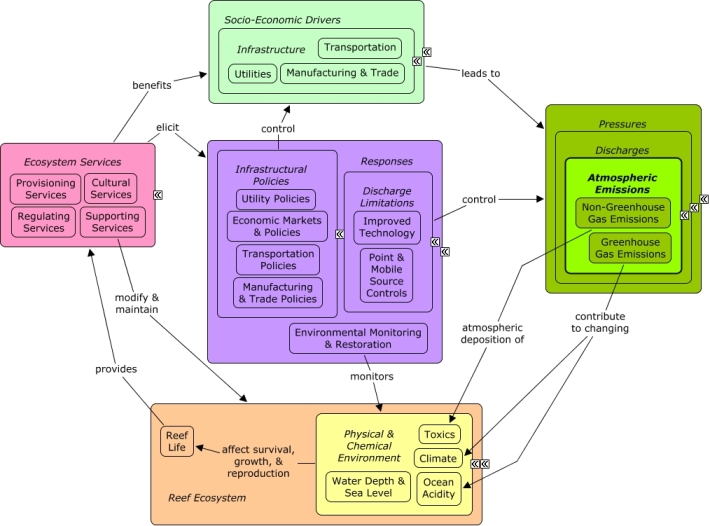ReefLink Database

Non-Greenhouse Gas Emissions
Non-Greenhouse Gas Emissions include emissions of non-methane hydrocarbon, nitrogen oxide, particulates, sulphur oxide, and volatile organic compounds. These emissions pollute the air, which has a negative effect on human health and the health of animals.
CMap

CMap Description
Atmospheric emissions from vehicles and factories can lead to atmospheric deposition of toxic metals, such as mercury, or increase levels of greenhouse gases and contribute to climate change and ocean acidification. Increasing sea temperatures, toxics, and ocean acidity can affect the survival and growth of reef life, including fish, coral, and other invertebrates. Many of the same socio-economic sectors which create atmospheric pollution benefit indirectly from goods and services provided by the reef which provides recreational opportunities and contributes to the cultural identity of the local community and drives coastal development. Atmospheric pollution can be controlled with point-source regulations and updating technology to reduce emissions.Citations
More than 50 citations. Click here to load.
| Citation | Year | Study Location | Study Type | Database Topics |
|---|
Management Options
| Management Option | Description | Sources | Database Topics |
|---|---|---|---|
| Discharge Controls: Air Filtration & Scrubbing | The management option reduces emissions of air contaminants from structures through interception and/or collection. These filters and scrubbers can be implemented on ventilation emitting particulate matter, volatile organic compounds, ammonia, odorous sulfur compounds, methane or other greenhouse gasses. There are many alternative filters and scrubbers depending on the ventilation system and the characteristics of the emissions. | Natural Resources Conservation Service. 2011. National Handbook of Conservation Practices. U.S. Department of Agriculture. |
Agriculture; Agriculture, Aquaculture, & Forestry Policies; Atmospheric Emissions; Carbon Storage & Cycling; Chemical Variables; Climate Regulation; CO2; Construction Codes & Projects; Discharges; Ecosystem Monitoring & Restoration; Energy Policy & Development; Environmental Monitoring & Restoration; Food & Energy Policies; Food & Raw Materials; Greenhouse Gas Emissions; Improved Technology; Infrastructural Policies; Manufacturing & Trade; Natural Gas & Electric Power; Non-Greenhouse Gas Emissions; Nutrient & Contaminant Processing; Ocean Acidity; Regulating Services; Solid Waste Disposal; Supporting Services; Toxics; Utilities; Utility Policies |
| Transportation Policy: Corporate Average Fuel Economy Standards | The purpose of Corporate Average Fuel Economy (CAF�) standards is to reduce fuel consumption by increasing the fuel economy of cars and light trucks. NHTSA sets fuel economy standards for cars and light trucks sold in the US while EPA calculates the average fuel economy for each manufacturer. Since the standard only dictates the average fuel economy, manufacturers can sell vehicles with higher or lower fuel economy than the standard. | National Highway Traffic Safety Administration. Corporate Average Fuel Economy (CAFE). Accessed 8/11/2011. |
Atmospheric Emissions; Carbon Storage & Cycling; Climate; Climate Regulation; CO2; Energy Policy & Development; Food & Energy Policies; Greenhouse Gas Emissions; Land & Air Transportation; Manufacturing & Trade; Manufacturing & Trade Policies; Non-Greenhouse Gas Emissions; Ocean Acidity; Oil & Gas Industry; Provisioning Services; Regulating Services; Resource Use Management; Supporting Services; Transportation; Transportation Policies |
Laws
| Legal Citation | Purpose of Law | Management Organization | Database Topics |
|---|---|---|---|
| Air Pollution Control, 62-204 Florida Administrative Code (1996). | 62-204.100 Purpose and Scope.
(1) This chapter establishes maximum allowable levels of pollutants in the ambient air, or ambient air quality standards, necessary to protect human health and public welfare. This chapter also establishes maximum allowable increases in ambient concentrations for subject pollutants to prevent significant deterioration of air quality in areas where ambient air quality standards are being met. It further specifies approved air quality monitoring and modeling methods.
(2) In addition, this chapter designates all areas of the state as attainment, nonattainment, or unclassifiable with respect to each pollutant for which ambient air quality standards have been adopted; further designates certain attainment and unclassifiable areas of the state as air quality maintenance areas for particular pollutants; classifies all areas of the state as Class I, Class II, or Class III for determining which set of prevention of significant deterioration (PSD) increments apply; and designates all attainment and unclassifiable areas of the state as one or more PSD areas for determining which pollutant-specific PSD baseline dates apply. This chapter also sets forth procedures for redesignating and reclassifying areas as above.
(3) The Department of Environmental Protection adopts this chapter to identify the Florida State Implementation Plan (SIP) required by the U.S. Environmental Protection Agency pursuant to 40 C.F.R. Part 51; to set forth the public notice and hearing requirements that the Department will adhere to for making SIP revisions; and to set forth the definitions, criteria, and procedures that the Department will use to review a federal agency�s general conformity determination, made pursuant to 40 C.F.R. Part 51, Subpart W; and to adopt by reference an interagency memorandum of agreement that the Department will comply with to review any transportation conformity determination, made pursuant to 40 C.F.R. Part 51, Subpart T. The provisions to 40 C.F.R. 51.853 require that a federal agency make a general conformity determination for any federal agency action in a nonattainment or maintenance area, to ensure that such action is consistent with the SIP and that such federal conformity determination be reviewed by the affected state. The provisions of 40 C.F.R. 51.394 require that a transportation conformity determination be made for the adoption, acceptance, approval, or support of certain transportation plans, transportation improvement programs, and transportation projects in nonattainment and maintenance areas for transportation-related criteria pollutants to ensure that such actions are consistent with the SIP.
(4) Finally, this chapter adopts and incorporates by reference federal air pollution control regulations which are referenced in whole or in part throughout the Department�s air pollution control rules. Application to Coral Reefs:By reducing emmissions to air, particularly carbon dioxide, the pH of ocean waters will not be reduced and that is a direct benefit to coral reefs, since a reduction in pH is believed to be detrimental to corals. Legislative Actions:The Chapter designates all areas of the state as attainment, nonattainment, or unclassified with respect to each pollutant for which ambient air quality standards have benn adopted. Comments:This chapter establishes maximum allowable levels of pollutants in the ambient air, or ambient air quality standards, necessary to protect human health and public welfare. This chapter also establishes maximum allowable increases in ambient concentrations for subject pollutants to prevent significant deterioration of air quality in areas where ambient air quality standards are being met. It further specifies approved air quality monitoring and modeling methods. |
Florida State Department of Environmental Protection Jurisdiction: |
Atmospheric Emissions; Calcium Carbonate Deposition; Carbon Storage & Cycling; Chemical Use Regulations; CO2; Commercial Fishing Boats; Cruise Ships; Energy Policy & Development; Greenhouse Gas Emissions; Land & Air Transportation; Natural Gas & Electric Power; Non-Greenhouse Gas Emissions; Nutrients; Ocean Acidity; Oil & Gas Tankers; Point & Mobile Source Controls; Primary Production; Resource Use Management; Transportation Policies; Wetlands; Wood, Plastics, & Chemical Products |
| Clean Air Act, 42 United States Code §§ 7400 et seq. | To ensure Americans have clean air to breath, and to protect the environment from air pollution. Regulates air emmissions from area, stationary and mobile sources. Charges federal land managers with direct responsibility to protect the "air quality and related values" of land under their control. The "related values" include fish and widlife and their habitats. The Clean Air Act is the law that defines EPA's responsibility for protecting and improving the nation's air quality and the stratospheric ozone layer. Application to Coral Reefs:The Act would decrease carbon dioxide emissions from sources in the United States, thereby making a contribution toward reducing ocean acidification, which is one of the problems contributing to coral reef decline. Legislative Actions:Response will differ from State to State because many Sates have been delegated to administer the Clean Air Act. However, States cannot have air quality standards less stringent then the federal standards. State air pollution agencies hold permit hearings and fines industries that violate air quality limits. States must develop state implementation plans that require approval by EPA. Comments:The 1990 amendments authorized the Acid Deposition Control Program, a program to control 189 toxic pollutants, established permit program requirements, expanded and modified the attainment of National Ambient Air Quality Standards, and expanded and modified enforcement authority. |
United States Environmntal Protection Agency Jurisdiction: United States |
Carbon Storage & Cycling; Climate Regulation; CO2; Energy Policy & Development; Environmental Monitoring, Mapping, & Scientific Research; Greenhouse Gas Emissions; Improved Technology; Mineral, Rock, & Metal Mining; Natural Gas & Electric Power; Non-Greenhouse Gas Emissions; Nutrient & Contaminant Processing; Nutrients; Oil & Gas Research & Exploration; Oil & Gas Rigs; Point & Mobile Source Controls; Political Pressure; Transportation Policies; Wood, Plastics, & Chemical Products |
| Tampering with Motor Vehicle Air Pollution Control Equipment, 62-243 Florida Administrative Code. | The Department of Environmental Protection adopts this chapter to establish
procedures to determine compliance with those parts of Section 316.2935, F.S., which
provide that no person shall operate on the public roads or streets of this state any
motor vehicle that has been tampered with and that no person or motor vehicle dealer
as defined in Section 320.27, F.S., shall offer or display for retail sale or lease, sell,
lease or transfer title to a motor vehicle in Florida that has been tampered with.
Specific Authority: 316.2935, F.S.
Law Implemented: 316.2935, 316.6105, 318.18, 325.209, F.S.
History.: New 2-21-90, Amended 5-29-90, Formerly 17-243.100. Application to Coral Reefs:Vehicles with properly operating air pollution control equipment will dischage less air polllutants and will contribute to a decrease in ocean acidification. Legislative Actions: Comments:To achieve and maintain the National Ambient Air Quality Standards for ozone, carbon monoxide, and particulate matter; and to control nuisance exhaust by ensuring that that the air pollution control equipment of the motor vehicle has not been tampered with. |
Florida State Department of Environmental Protection Jurisdiction: |
Atmospheric Emissions; CO2; Greenhouse Gas Emissions; Land & Air Transportation; Non-Greenhouse Gas Emissions; Point & Mobile Source Controls; Transportation Policies |
